The Cornell Lab Bird Academy › Discussion Groups › Joy of Birdwatching › Activities: Local Bird Exploration
-
Activity 1: I just put up my first bird feeder today! I watched it, and there was some but not too much activity. Hopefully the birds I saw will spread the word to others! I saw a gold finch, and another bird with reddish coloring around it's head/chest area and brownish/gray the rest. By the time I got my binoculars out to get a closer look it was gone, but I wasn't sure if it was maybe a juvenile or female cardinal, or a house finch. Activity 2: I was honestly amazed when I looked at Merlin's most likely list for my area-there were way more species than I thought there would be! Many are birds I would expect by the lake shore but not right in my neighborhood. Listening to the sounds-one song I recognized but hadn't known which bird it was is the Northern Cardinal! Activity 3: I used ebird to look at birds at a nearby hotspot, and I read about the Ruby Crowned Kinglet, Veery, Bonaparte's Gull, Hooded Merganser, and Black billed Cuckoo.
-
I go to the Ravine in Central Park almost every day. Yesterday I used Merlin to identify a gray cowbird, yellow-throated warbler, northern cardinal, blue jay, & house sparrow.
-
Using the Cornell Live Cam, I identified Black capped Chickadee, male Cardinal, Red-winged Blackbird, Blue Jay, Common Grackle, Hairy Woodpecker, and Baltimore Oriole. In my yard, I spotted a Rose-breasted Grosbeak.
-
 Anna's hummingbirds are abundant in my neighborhood in Sunnyvale, California. I've since had to move this feeder and I've had several birds stop by looking for it. It's just one story below. These are the birds I saw most in March, but since I've seen mourning doves and crows nearby. In fact, there's a nest of doves in the rain gutter above me. The crows have definitely been pestering them. I've noticed several flycatchers from this balcony, but haven't been able to identify them.
Anna's hummingbirds are abundant in my neighborhood in Sunnyvale, California. I've since had to move this feeder and I've had several birds stop by looking for it. It's just one story below. These are the birds I saw most in March, but since I've seen mourning doves and crows nearby. In fact, there's a nest of doves in the rain gutter above me. The crows have definitely been pestering them. I've noticed several flycatchers from this balcony, but haven't been able to identify them.
 We went to take a look at goslings at at a lake nearby and spotted a grackle among them! First time I've ever identified a grackle. A beautiful bird. And though there were several PROMINENT signs admonishing people not to, a woman was feeding crackers to a groups of aggressive Canadian geese.
We went to take a look at goslings at at a lake nearby and spotted a grackle among them! First time I've ever identified a grackle. A beautiful bird. And though there were several PROMINENT signs admonishing people not to, a woman was feeding crackers to a groups of aggressive Canadian geese. -
Local Bird Exploration, Activity 2, Using Merlin's list of birds nearby I developed a visit plan to two spots nearby in Estero FL. Before I left I sorted Merlin for the most likely to see on the first few pages as its default look unmanageable (100+ by type).It turned out to be mostly correct. As I drove tot the first spot (River Park) a boat tailed grackle flew by. I went to the river first where I saw an Osprey and a Common Crow fly by but no wading birds or ducks. Walking back to my car was a small clearing in the shrubs of about 30' in diameter with lots of butterflies. While looking at them a pair of cardinals came by: see first photo below.
 A bluejay came by but failed to get his picture taken.
Next stop was a spot my wife told me "always has lots of white birds. There are two ponds part of the irrigation system and interconnected ponds for our golf course. A brown thrasher flew by as I was walking over the grass to get closer to a small group of wading birds about 500' away. As there are several large alligators around and it is the beginning of mating season, I did not go as close as I might have in January.
The birds largely stayed in the same place and I took several photos over a few minutes. My 150X telephoto on Olympus E-M1 helped me see things when I got back to my computer that I didn't see with my bare vision. The first grouping has a little blue heron and a great egret and several ibis. What I hadn't seen before was the snowy egret landing. Black beak and yellow feet were visible by chance in the landing.
A bluejay came by but failed to get his picture taken.
Next stop was a spot my wife told me "always has lots of white birds. There are two ponds part of the irrigation system and interconnected ponds for our golf course. A brown thrasher flew by as I was walking over the grass to get closer to a small group of wading birds about 500' away. As there are several large alligators around and it is the beginning of mating season, I did not go as close as I might have in January.
The birds largely stayed in the same place and I took several photos over a few minutes. My 150X telephoto on Olympus E-M1 helped me see things when I got back to my computer that I didn't see with my bare vision. The first grouping has a little blue heron and a great egret and several ibis. What I hadn't seen before was the snowy egret landing. Black beak and yellow feet were visible by chance in the landing. A few minutes later the great heron was gone but the little blue and ibis were joined by what I had always thought were coots but today learned they were common gallinules. The long green legs identify the female as such. My homework for tonight is to figure out what a gallinule is all about.
A few minutes later the great heron was gone but the little blue and ibis were joined by what I had always thought were coots but today learned they were common gallinules. The long green legs identify the female as such. My homework for tonight is to figure out what a gallinule is all about.
-
Using Merlin’s most likely birds in my area of Westchester County, NY, I have seen the following birds: Grackles, European Starlings, Red-Winged Blackbirds, Baltimore Oriole, Double-Crested Cormorants, Mourning Doves, and one Goldfinch. I used Merlin to see that the Baltimore Oriole migrates from the south and breeds in the north. The double-crested cormorants live year-round in Florida, migrate from the south, and breed mostly in the northern mid-west. The goldfinch is found year- round here in New York, but breeds in Canada- interesting!
-
Looking at my bird feeder, here in Rhode Island, I have seen many American Goldfinches, some house finch and a song sparrow. So I did not know what they were except the goldfinch and feel good I now can recognize the song sparrow and house finch. Thanks you for this course.
-
 Hello. I am taking this course in Hokkaido, Japan. Yesterday, I went to Lake Toya with my husband to see cherry blossoms. We saw and hear lots of birds, most of which we could not identify. I am sorry I can not find a suitable content pack to be installed for my Merlin. Anyway, here is a picture of Varied Tit. We could also identified Japanese Willow Tit, Narcissus flycatcher, Black-faced Bunting, Japanese nightingale, Eastern Crowned Warbler, Oriental Greenfinch, White Wagtail and some water fowls.
We usually do birding from our window or while walking around the neighbourhood. There are flocks of Dusky Thrushs in our back yard now.
Hello. I am taking this course in Hokkaido, Japan. Yesterday, I went to Lake Toya with my husband to see cherry blossoms. We saw and hear lots of birds, most of which we could not identify. I am sorry I can not find a suitable content pack to be installed for my Merlin. Anyway, here is a picture of Varied Tit. We could also identified Japanese Willow Tit, Narcissus flycatcher, Black-faced Bunting, Japanese nightingale, Eastern Crowned Warbler, Oriental Greenfinch, White Wagtail and some water fowls.
We usually do birding from our window or while walking around the neighbourhood. There are flocks of Dusky Thrushs in our back yard now. -
I live in Central Ontario near Georgian Bay. For Activity 1, I tried using Merlin for the first time even though I've had it on my phone for months. It was pretty fun looking for keys to bird identification using the easy questions Merlin poses. Because it was snowing (in May!!!) I stuck to viewing birds through my window :) For Activity 2, Merlin's "Most Likely" told me that Baltimore Orioles should be back in the area so I added an orange half to my bird feeder. Bingo! This morning a male oriole visited and I expect to see him back. Hopefully he will bring a friend. For Activity 3, I used Merlin's birdsongs to check and hear whether the new song I was hearing came from visiting White-Crowned Sparrows or if I'd have to continue my quest to discover the singer. Sure enough, the new song matched the one on Merlin for the White-Crowned Sparrow. They visit my feeder every fall and spring but I don't think I'd heard their song before. These lessons have been great for making me look and listen more intently. I'm hoping to head out later this week to Stayner Lagoon which is a local hotspot. Taking Merlin with me as my new aide.
-
Activity 3 Sort-of Update. From the course, I ended up putting myself on Cornell''s rare species alert for my region (Barnstable County, MA USA), so I decided to go try to find the Purple Gallinule that has been listed for several days in a row at a location about 10 miles from my home. I went to the right "spot" using the google map plus luck, but would never have seen it, without the graciousness of two gentlemen with binoculars who exited their car at the same time as me - (there were only 4 cars there and the others were off hiking). They assented to me tagging after them - which turned out to be about a 10 yard tag - but they knew how and where to look, and waved me over after a few minutes. Beautiful colors! I stayed and watched for a while. Here is a poor I phone photo

-
Activity 1: For Big Global Day, I spent 30 minutes in my backyard this evening (May 9.) The very first bird I encountered was a male Ruby -throated hummingbird - or so I assumed since his throat was a brilliant fuchsia color! Next I saw his female counterpart in colorful green. Both spent several minutes, individually feeding at my feeder. But guess what?! To confirm the ID, I looked up ruby-throated hummingbirds in American Museum of Natural History "Birds of North American Wester Region" bird guide and this hummingbird was not listed. I then consulted the Merlin app and learned the RTHB does not hang out in COLORADO, but the Broad-tailed Hummingbird does! Score for guidebooks and apps. My other positive IDs included: Red-tail hawk mama sitting on nest, spotted towhee, black-capped chickadee, house finch, black-billed magpie, eurasian collared dove, and I learned that house wrens have taken up residence in a vacant bird house! Greenwood Village, Colorado 80111
-
Activity 1: We expected high levels of different migrating birds this weekend in north FL due to the change in weather and it has been busy indeed. I saw a pair of Purple Finches (they could have been House Finches, I didn’t get a good look at the male’s breast.) Ovenbirds are migrating through and I used Merlin to identify these birds that were previously unknown to me. Sadly, 2 have flown into my window and perished. I also saw severalDowny Woodpeckers, Carolina Chickadees, & Tufted Titmouse today as well.
-
Combining activity 2 and 3 in my fashion, I focused on identifying and learning more about some common local birds. I was happy to distinguish (elementary, I am sure!) an Eastern Towhee by notating (in my fashion) its song while in the field and then listening to a couople of possiblities when I returned home. Similarly from using Merlin and then listening to songs, I identified and then read up on the black capped chickadee which is a new favorite bird for me. Also getting familiar with Northern Flicker, which I realize I hear often in my yard and nearby. Realized that many of us have been calling tree swallows in a nearby field "barn swallows" although there are some of these around - the swallows we see have bright white breast/belly feathers and steal the blue bird nesting boxes. I have gotten better with my binocular, have purchased the Kaufman North America Field guide and use it, joined a local birder Face Book page, and love seeing their wonderful photos, which on occasion confirm what I have identified, and in many ways is edifying and delightful. Almost anyone I walk or sit with outside knows more about bird than me - so I am enjoying picking up bits of understanding here and there. If I don't try to "get" too much at once, I find it all a very delightful way to enjoy being in nature. OH - I also now get "rare" bird alerts, which is acquainting me with some new areas to go walking - even though I have not yet rushed out to see a rare bird!
-
Today I took a different birdwatching walk and headed to the pier at Quincy Bay, coastal MA south of Boston. With the help of Merlin App and the The Audubon Society Field Guide, if identified many Barn Swallows living at the pier. I now know they have migrated from South and Central America for breeding. What expert flyers they are! So fast and agile as they zoom along catching insects (way too fast for a photo, always on the move). They must make their mud nests underneath the pier, but I was unable to see them. Later I saw some again around a small fresh water pond (I assume they need fresh water to drink). What fun! This course has really enhanced my enjoyment of birding. Stay safe. Ann
-
After the last lesson, I knew how to locate a "hot spot" so I looked up one near us on Long Island and we went there (wearing masks and social distancing of course). I was disappointed we didn't hear or see more birds, but using the app we could identify a Gray Catbird as well as an Eastern Towhee. This morning on my walk I was able to identify the song of the Black-capped Chickadee which had stumped us on an earlier outing. We put up a feeder but have not attracted any birds yet, so I enjoyed watching the bird cam from Sapsucker Woods - I could watch it for hours! A great way to practice identifying birds too.
-
Over the last three days here in northern New Jersey I have seen catbirds, male and female orioles, grosbeak, a bluebird, robins and the hummingbirds have returned. It is very interesting to see how the regular year round birds like the blue jays, cardinals, woodpeckers, nuthatches and mourning doves interact with the newly arrived migrating birds at the feeder. There is a definite pecking order and sometimes the party gets a bit rowdy!
-
Merlins's Most Likely found many of the same birds I see in my local area in Northeast Wisconsin. A few I didn't mention, but they are also here are Red-winged Blackbirds, Mallard ducks, Common Grackle, American Crow, Canadian Geese, Song Sparrow and Tree Swallows. There were many, many others mentioned. This area is great for bird watching.
-
Bird watching in the month of May in NE Wisconsin is great. Here are some of the migrating birds I have seen in my yard since the last week of April or so. Eastern Bluebirds, Robins, Baltimore Oriole (just came in about 2 days ago) and Brown-headed Cowbird. I'm still waiting for the Indigo Buntings and the Red Breasted Grosbeaks to come in. Two of my favorites. Then there are my local year round favorites: American Goldfinches (with bright yellow summer colors), Black capped chickadee, Red-breasted Nuthatch, Morning Doves, Northern Cardinals, Blue Jays, Downy and Red-bellied Woodpeckers. I tried to get a few pictures to share. Tricky to capture some though.. I was able to snap a picture of the Oriole. I typically use the Peterson Field Guide for Eastern Birds for identification. I have had it for years and reference it often. My new favorite reference is the Merlin App. I am pretty sure the other bird pictured below is the Red-bellied woodpecker, although sometimes I get it confused with the Northern Flicker.
![20200505_064408[1]](data:image/gif;base64,R0lGODlhAQABAAAAACH5BAEKAAEALAAAAAABAAEAAAICTAEAOw==)
![20200507_170619[1]](data:image/gif;base64,R0lGODlhAQABAAAAACH5BAEKAAEALAAAAAABAAEAAAICTAEAOw==)
-
1. I feel so fortunate to be watching a Barn Owl in my neighborhood on a Webcam, The Mother Barn Owl laid 5 eggs in April. Incubation is approximately 30 days. Four have hatched, one is left. It is hard to get a good look at the babies because they are so small but I can see their movement under her wings. When she stands, I have seen her caress the babies with her talons which I know have very sharp claws. Nevertheless, she strokes them, one at a time. I have seen her fly in with a rodent and then eat it. She does a lot of preening of her feathers and occasionally will expand her wings almost as another way of protecting her babies. My grandchildren made me an owl box for Christmas which will be mounted early next year with the hopes of housing an Owl family. 2. Likely birds in the area that I have identified and seen within the last few days are Dark-eyed Junco's, California Scrub-Jays, California Towhee, Acorn Woodpecker, Violet-green Swallow, American Robin, and a Northern Mockingbird. The Northern Mockingbird was at a friend's house who has learned to call the mockingbirds to her. This one came about a month ago, injured with half its beak gone. As it was very thin and unable to get a good grip on food, she helped by feeding it mealworms. The bird will come to her but until I was there , would not come down when anyone else was around. I felt privileged that the bird felt it could come to the feeder while I was there approximately two feet away.
-
Sat on my back deck and watched birds while working this morning. Really enjoyed watching a pair of nesting robins forage and bring their three little chicks food, as well as remove white fecal sacs from the nest! Other treats were a calliope and a rufous humming bird, each of which flew right up to me and hovered in front of my face checking me out. I saw two birds that I didn't know, a yellowish, grayish songbird, and some sort of sparrow with a lovey rust-brown cap. Using a field guide and Explore birds, I decided the sparrow was a chipping sparrow (black eye stripe, white brow, striped tan and brown back, and light, un-striped breast - although I saw a very faint rust-brown spot in the middle of its breast, something I couldn't find in my book or online), which was exciting because friends have identified them by ear for me before, but today I finally got a really good look at one. Has anyone else seen a chipping sparrow with a breast spot? The songbird was harder - very distinct white eyering, gray head, yellow breast, dark yellow/olive wings, yellow on the rump and under the tail, but a bit more white under the legs. It was moving around pretty fast, but I watched it for five minutes or so and took down all those details. My best guess is a Nashville warbler.
-
Watching back yard feeder and pond early this morning and later in the afternoon. Saw a few Brown headed cowbirds and house finches at our feeder. A crane waded around the pond for a little while, as did a goose couple with three goslings. A mallard couple has also been in/around the pond over the past couple weeks, but lately it’s been just the male. We’ve been hearing a bird singing around sunrise over the past several days and I’ve been searching Merlin’s “most likely species” feature to find a match to the call/song. I think that it’s a Scarlet Tanager, but haven’t actually seen it yet. Need to get out around daybreak to look for it.
-
This morning just reporting on activity 1, as I went to stand at a favorite spot the other day, as - when departing from a nearby spot earlier in the week my friend slowed her car and pointed - and later told me that she saw night herons, which I did NOT see then. SO, I went and stood with my binoculars late one afternoon - not considered "prime time" but it was the time I had - and close up, I watched a red wing black bird, mid vision cormorants perching on posts sticking up from the water, and occasionally drying their wings, far off to the left while I was watching some great egrets, down and around swooped an immature bald eagle (no white head). Bald eagles have only recently returned to nest in Barnstable County, MA - so still thriling to see them. I had only seen the "classic" white heads before - and thanks to this course when it LOOKED like a bald eagle but with different head color, I trusted myself to check further and confirm, and finally - looking off to the far right ... I saw two night herons (I am going to need to comce back to edit whether black crowned or other) perching at the very top of some medium sized pines ... I realized that when people told me "look in the trees" I was looking too low down. I am facebook friends with two local spectacular bird photographers (and now the local bird club). One of them recently posted a beautiful photo of a night heron in flight at sunset - which I hope to see in person some day. So that is what I saw, standing still late one afternoon.
-
I work for Missouri State Parks and I am doing this class as part of my continuing education. I know several birds but there are so many more and so much more to learn and I am excited that this class has helped tremendously with ideas on how to explain bird id to others. I have even made up an Observation sheet to help with a future event that is coming up. With that I was able to get some field work in this afternoon. I spent approx. 30 min at Current River State Park in Missouri set my timer for 15 min. and then there were so many birds I just kept watching. The list is relatively short but I was watching and noting behaviors. Indago Bunting 3 adult males 1 juvenile male at least 1 female. They were really fun to watch they were eating and occasionally one bird would jump over the other like leap frog! Several brown headed cowbirds, they were eating as well. Two Eastern Kingbirds. a Carolina Wren, Crows, Gold Finches, Northern Cardinal and a couple that I didn't get a good enough look at to be able to id. I spent 15 min. at Echo Bluff state park and only SAW one bird a Turkey Vulture soaring overhead. I heard several and tried using the Audubon app. sounds to help not sure if Merlin has that feature I am still learning it. I know that I heard a crow and a Northern Cardinal but other than that unsure but could have been around 7-9 different birds per vocals.
-
My backyard in Long Island New York has started to see some new visitors with the coming of Spring and warmer weather. The last 3 weeks have brought us Brown-headed Cowbirds, Yellow-rumped Warblers, and American Goldfinch's. My eyes are open for more visitors as it warms up more. Stay safe and healthy everyone.
-
1. The birds that I saw were: Sulphur Crested Cockatoo, Rainbow Lorikeet, King Parrots, Noisy Minors, Crimson Rosella, and Currawong 2. I have checked on Merlin for the birds most likely to be found in our area. Going out to look for them is not practical at the moment. I will however go asap. I will also continue to watch from our back deck. 3. 5 birds that apparently can be found in our area that I have not seen are: Little Lorikeet, Eastern Yellow Robin, Rose Robin, Eastern Spinebill, and Golden Headed Cisticola. I am on their case!
Read More:
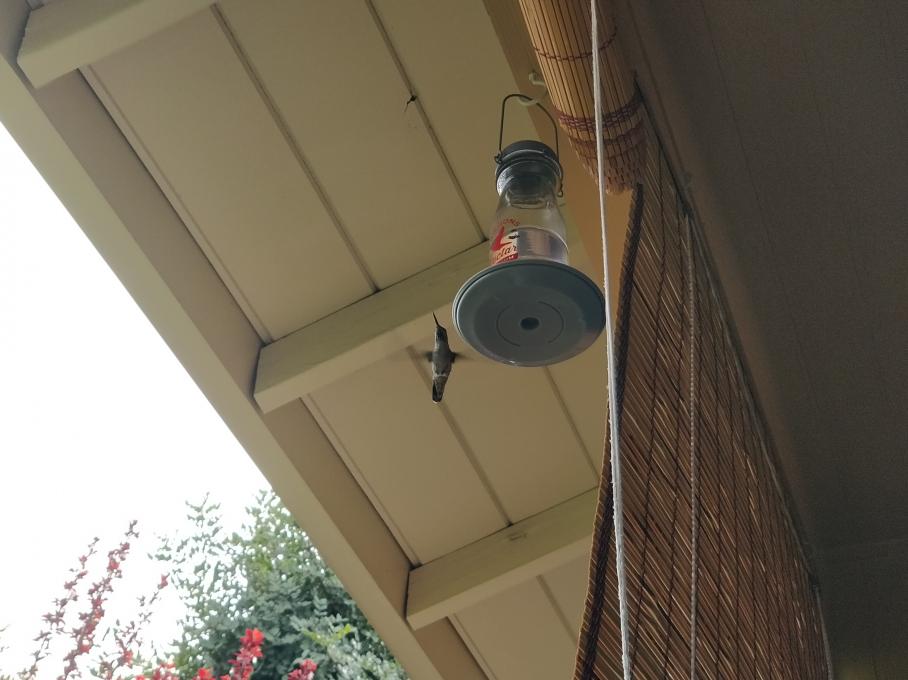 Anna's hummingbirds are abundant in my neighborhood in Sunnyvale, California. I've since had to move this feeder and I've had several birds stop by looking for it. It's just one story below. These are the birds I saw most in March, but since I've seen mourning doves and crows nearby. In fact, there's a nest of doves in the rain gutter above me. The crows have definitely been pestering them. I've noticed several flycatchers from this balcony, but haven't been able to identify them.
Anna's hummingbirds are abundant in my neighborhood in Sunnyvale, California. I've since had to move this feeder and I've had several birds stop by looking for it. It's just one story below. These are the birds I saw most in March, but since I've seen mourning doves and crows nearby. In fact, there's a nest of doves in the rain gutter above me. The crows have definitely been pestering them. I've noticed several flycatchers from this balcony, but haven't been able to identify them.
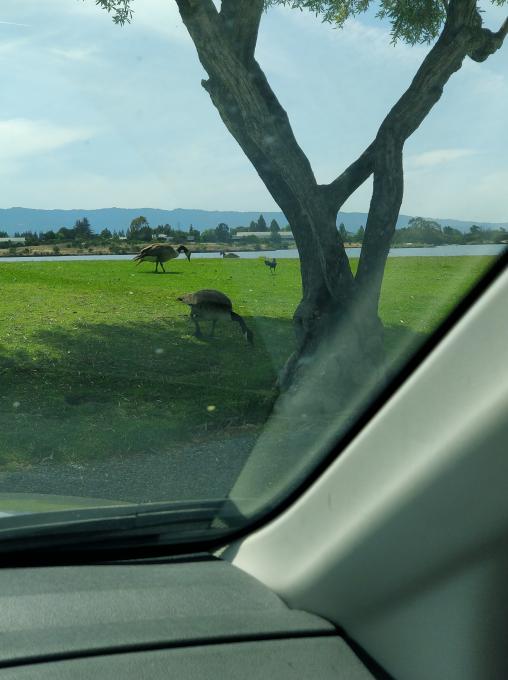 We went to take a look at goslings at at a lake nearby and spotted a grackle among them! First time I've ever identified a grackle. A beautiful bird. And though there were several PROMINENT signs admonishing people not to, a woman was feeding crackers to a groups of aggressive Canadian geese.
We went to take a look at goslings at at a lake nearby and spotted a grackle among them! First time I've ever identified a grackle. A beautiful bird. And though there were several PROMINENT signs admonishing people not to, a woman was feeding crackers to a groups of aggressive Canadian geese. 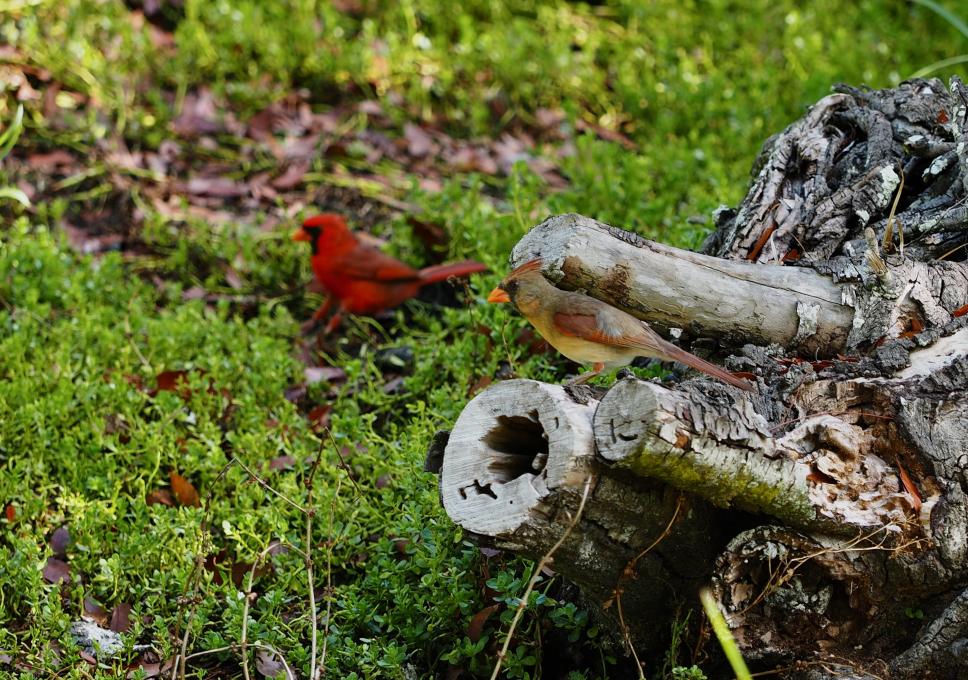 A bluejay came by but failed to get his picture taken.
Next stop was a spot my wife told me "always has lots of white birds. There are two ponds part of the irrigation system and interconnected ponds for our golf course. A brown thrasher flew by as I was walking over the grass to get closer to a small group of wading birds about 500' away. As there are several large alligators around and it is the beginning of mating season, I did not go as close as I might have in January.
The birds largely stayed in the same place and I took several photos over a few minutes. My 150X telephoto on Olympus E-M1 helped me see things when I got back to my computer that I didn't see with my bare vision. The first grouping has a little blue heron and a great egret and several ibis. What I hadn't seen before was the snowy egret landing. Black beak and yellow feet were visible by chance in the landing.
A bluejay came by but failed to get his picture taken.
Next stop was a spot my wife told me "always has lots of white birds. There are two ponds part of the irrigation system and interconnected ponds for our golf course. A brown thrasher flew by as I was walking over the grass to get closer to a small group of wading birds about 500' away. As there are several large alligators around and it is the beginning of mating season, I did not go as close as I might have in January.
The birds largely stayed in the same place and I took several photos over a few minutes. My 150X telephoto on Olympus E-M1 helped me see things when I got back to my computer that I didn't see with my bare vision. The first grouping has a little blue heron and a great egret and several ibis. What I hadn't seen before was the snowy egret landing. Black beak and yellow feet were visible by chance in the landing.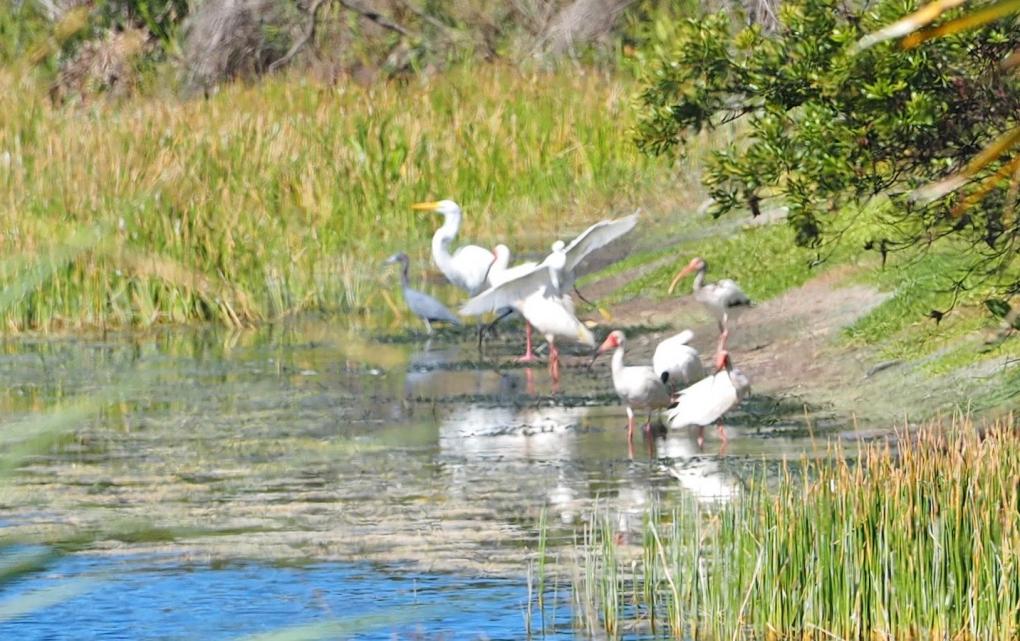 A few minutes later the great heron was gone but the little blue and ibis were joined by what I had always thought were coots but today learned they were common gallinules. The long green legs identify the female as such. My homework for tonight is to figure out what a gallinule is all about.
A few minutes later the great heron was gone but the little blue and ibis were joined by what I had always thought were coots but today learned they were common gallinules. The long green legs identify the female as such. My homework for tonight is to figure out what a gallinule is all about.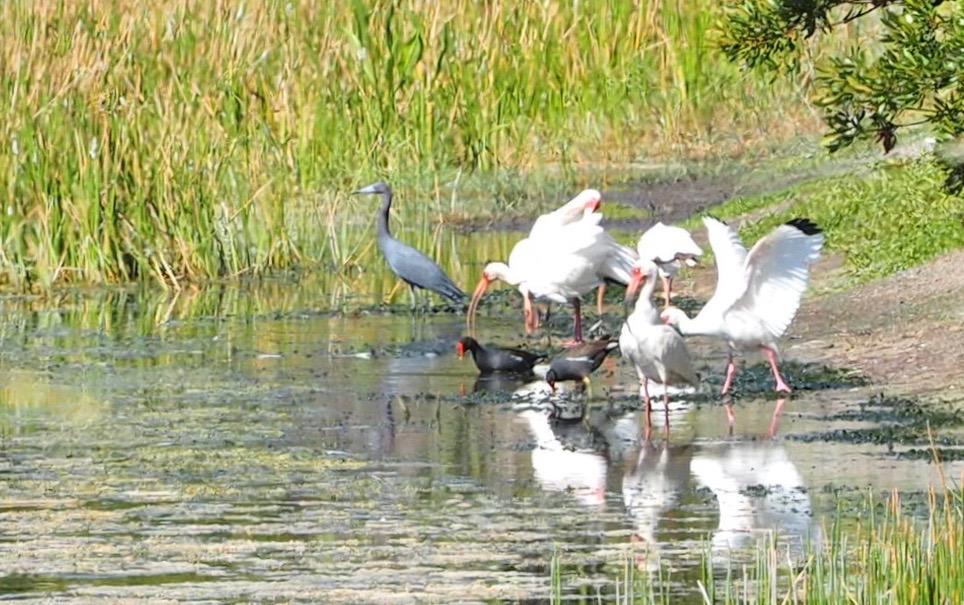
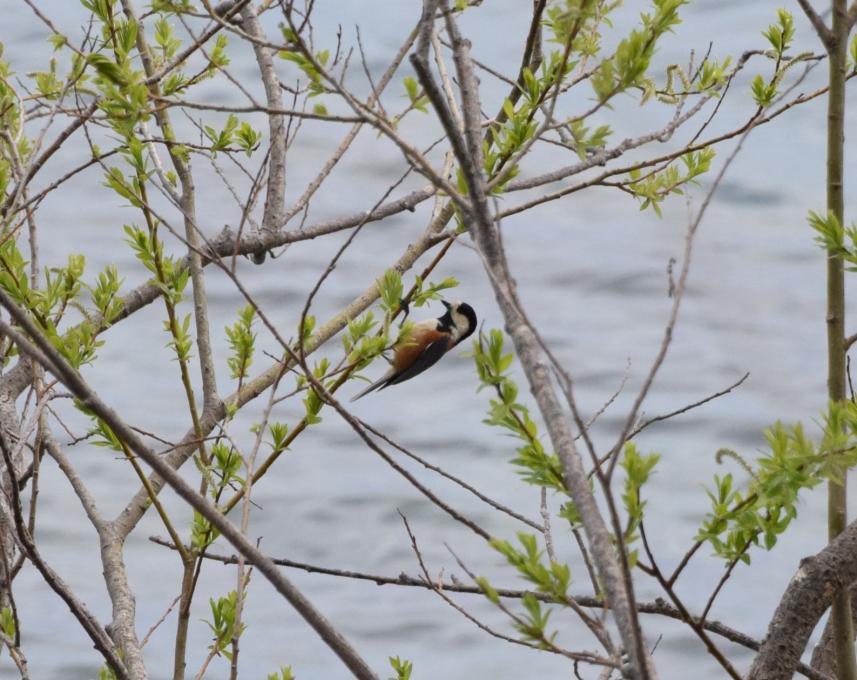 Hello. I am taking this course in Hokkaido, Japan. Yesterday, I went to Lake Toya with my husband to see cherry blossoms. We saw and hear lots of birds, most of which we could not identify. I am sorry I can not find a suitable content pack to be installed for my Merlin. Anyway, here is a picture of Varied Tit. We could also identified Japanese Willow Tit, Narcissus flycatcher, Black-faced Bunting, Japanese nightingale, Eastern Crowned Warbler, Oriental Greenfinch, White Wagtail and some water fowls.
We usually do birding from our window or while walking around the neighbourhood. There are flocks of Dusky Thrushs in our back yard now.
Hello. I am taking this course in Hokkaido, Japan. Yesterday, I went to Lake Toya with my husband to see cherry blossoms. We saw and hear lots of birds, most of which we could not identify. I am sorry I can not find a suitable content pack to be installed for my Merlin. Anyway, here is a picture of Varied Tit. We could also identified Japanese Willow Tit, Narcissus flycatcher, Black-faced Bunting, Japanese nightingale, Eastern Crowned Warbler, Oriental Greenfinch, White Wagtail and some water fowls.
We usually do birding from our window or while walking around the neighbourhood. There are flocks of Dusky Thrushs in our back yard now. 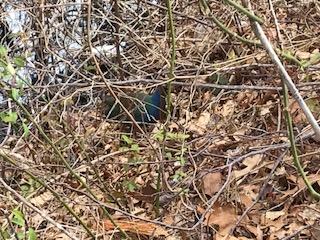
![20200505_064408[1]](https://academy.allaboutbirds.org/wp-content/uploads/hm_bbpui/699170/Tanoh8xvoh35or5rijjttc2iphsynv3zm.jpg)
![20200507_170619[1]](https://academy.allaboutbirds.org/wp-content/uploads/hm_bbpui/699170/T1q1cnlddtmj80cdlgvz3m3ob3z2e8ib1.jpg)